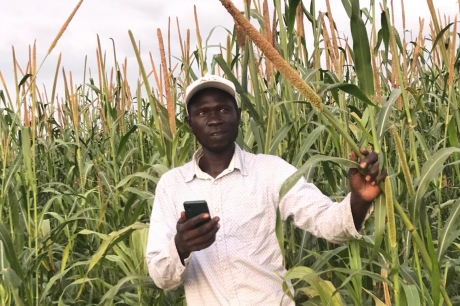Digital tools can help offset uncertainties in weather patterns caused by climate change.
In Nioro, Senegal, Mamadou Drame, a father of four children, now looks down at a screen instead of up at the skies to understand the weather and know what to plant. Historical rain cycles have become increasingly unreliable because of climate change, upsetting patterns of planting and harvesting. Thankfully, digital innovations have stepped in, assisting him to boost his rice, maize, millet and vegetable production. These tools are also helping in finding buyers and receiving payments on his phone.
In November 2016, the Food and Agriculture Organization of the United Nations (FAO) launched the Agricultural Services and Digital Inclusion in Africa (ASDIA) project, with Flexible Voluntary Contribution funding.
The project’s main objective was to provide farmers with real-time information on weather forecasts, best agricultural practices, livestock care, market prices, health and nutrition directly from specially developed applications on their cell phones.
With the “Weather and Crop Calendar” app, farmers have a new ability to predict the start and end of the rainy season accurately, as well as the frequency and expected amount of rain. This information allows them to choose the right type of seeds and timing for production cycles, avoiding the catastrophic losses that often occur in dry years.
“We have never had this kind of information or access to markets. It has completely changed how we think about this business. Now we can plan, plant, harvest, sell and earn with a security we have never had,” says Mamadou.
Digitalizing rural agriculture
Over the past 20 years, a cell phone, one little item that fits in a pocket, has provided humans with all the data and information needed to make informed decisions in almost all walks of life. In rural parts of West Africa, particularly in agriculture, this potential is untapped.
The quality of mobile infrastructure has improved dramatically in the region with many having already adopted mobile technologies. However, these tools are not yet commonly used by farmers as part of their production.
The opportunities for use in agriculture abound, such as maximizing the impact of existing rural advisory services, financial services, social protection programmes and market access directly from individual cell phones.
In Senegal, FAO has deployed the ASDIA project to help support the implementation of the digital agriculture strategy of Senegal’s National Agency for Agricultural and Rural Council (ANCAR), a body of the Ministry of Agriculture. The objective of their programme is to leverage digital tools to modernize local agriculture and help extension agents reach more farmers and cover larger territories.
FAO’s ASDIA programme has trained more than 1 000 ANCAR extension agents and local organisation leaders on the five phone applications related to agriculture and livestock production developed by the programme. These agents and leaders then pass this knowledge onto the farmers.
“We now know when to plant. With the information from ASDIA, we’re able to adapt our planting schedule to ensure that we get optimal rain,” says Mamadou.
Seven years since launching ASDIA, farmers are seeing the benefit of this technology on their agricultural activities and lives with improved yields, fewer expenses on inputs and fewer post-harvest losses.
Digital opportunity during the pandemic
In mid-2020, FAO additionally helped ANCAR build an e-commerce platform, senlouma.org, to assist approximately 500 Senegalese small-scale farmers to sell their products during the COVID-19 crisis. This was part of the rapid response to the devastating marketing problems and widespread rotting of agricultural products caused by the pandemic’s disruptions to the value chain.
“The platform was a lifesaver. It allowed us to sell our produce at the height of the pandemic, without breaking COVID-19 protocols,” remembers Mamadou.
The platform now boasts over 45 farmers’ organizations registered, with almost 4 000 people able to sell their produce online. ANCAR plans to use senlouma.org to connect producers in rural areas with seed traders, input suppliers, food processing specialists, insurance traders, wholesalers and financial institutions.
So far, beneficiaries from the Saloum and Niaye regions have discovered new markets and developed partnerships across the country especially in eastern regions like Tambacounda and Kedougou, where vegetable production is relatively underdeveloped.
The Senlouma platform was also selected to receive additional funds through an initiative by the Francophone University Agency in partnership with the National Agency for Applied Scientific Research in Senegal. This will assist beneficiaries to obtain commercial patents and scale up their initiatives in Benin, Burkina Faso, Senegal and Togo.
Increased local uptake of digital solutions
As of August 2022, Mamadou is now one of over 300 000 Senegalese farmers registered with ASDIA to receive these advisory messages in their local language. The African Development Bank (AfDB) also mobilized USD 1 million in 2022 to deploy ASDIA and other FAO digitalization initiatives to the Casamance region in southern Senegal, financing the development of new apps.
With the use of this technology, Mamadou has regained trust in his agricultural production: “I feel confident when I plant and set my prices. I know that I can earn enough to feed my family, take my children to school and grow my business.”
ASDIA is one part of the wider Senegalese model of the 1 000 Digital Villages Initiative (DVI) led by FAO. The DVI promotes rural transformation through digitalization of agriculture, addressing agricultural and non-agricultural bottlenecks and leveraging greater innovation for better production. The DVI places small-scale farmers at the centre of the fight against hunger, poverty and inequality. Senegal is among the nine African countries and multitude of countries worldwide participating in the DVI.
Story from: FAO Website

